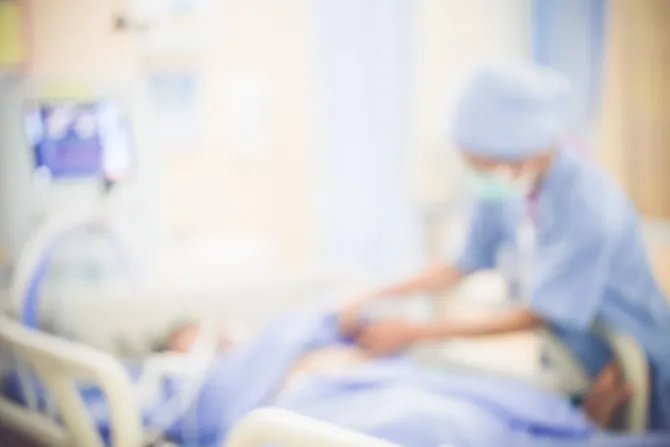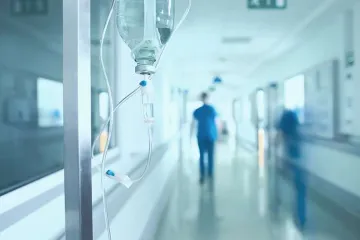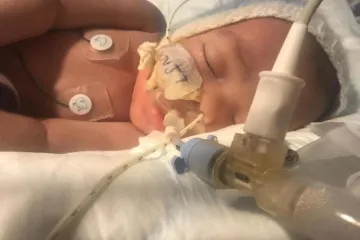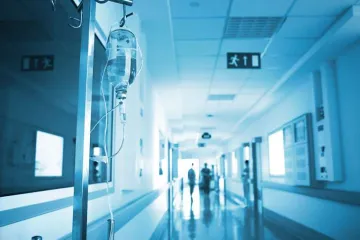Denver Newsroom, Apr 22, 2021 / 04:01 am
The Catholic Church is clear in its teaching on when life begins: at conception.
On death— described as “the end of man's earthly pilgrimage”— the Church teaches in the Catechism of the Catholic Church that “life is changed, not ended;” that death represents the moment of “the separation of the soul from the body.”
While the moment of human conception— the beginning of life— is well-understood and observed from a scientific standpoint, the exact moment of death can be harder to pin down.
This is especially true thanks to various forms of modern technology such as ventilators, which make it possible for doctors to declare a patient dead based on the state of their brain, even if their body appears, to the untrained eye, still to be alive.
Brain death, also called death by neurological criteria, is the practice of declaring a person dead based on the loss of brain function, rather than the stoppage of the heart and breathing.
Brain death is, today, a commonly accepted standard for declaring a person dead. According to the 1981 guidelines of the American Medical Association, brain death entails the “irreversible cessation of all functions of the entire brain.”
Most people are unlikely to need to think about brain death until it affects a loved one— but on a nationwide scale, the phenomenon is more common than one might think. An estimated 42 people are declared brain dead throughout the U.S. every day.
The issue is complicated by the reality of organ transplantation. Brain-dead donors are, today, the primary source of organ transplants.
Organs such as the heart, lungs, and pancreas can be— and are— harvested from brain dead donors as close to the time of death as possible. Donors’ bodies are sometimes given painkillers to stop involuntary movements originating from the spinal cord.
What Catholics should make of this
The term “brain death” is not found in the Catechism of the Catholic Church. But a statement from St. John Paul II has asserted that, if properly diagnosed, the complete and irreversible cessation of all brain function seems a valid way to assess with moral certainty that a person has died.
Moral certainty, St. John Paul II has said, “is considered the necessary and sufficient basis for an ethically correct course of action.”
Catholic doctors and ethicists today largely echo the Vatican in stating that brain death, when properly diagnosed, is not a “kind” of death; it is simply death, period.
However, brain death remains a hotly debated topic among some Catholic medical professionals and ethicists.
One Catholic doctor told CNA he is concerned that proposed changes to U.S. law regarding brain death could make it easier for doctors to diagnose, and thus may remove some of the rigor that the Church requires for moral certainty about brain death.
What brain death is
(Story continues below)
A Harvard Medical School Ad Hoc Committee introduced the concept of “brain death” in August 1968— less than a year after the first successful heart transplant, performed in South Africa in December 1967.
That document from the Harvard committee introduced the idea that in addition to using “irreversible cessation” of cardiorespiratory function as a criterion for death, doctors also can use irreversible cessation of brain function to determine death.
While legal standards for determining brain death differ from country to country, in the U.S. the law relevant to brain death is the Uniform Determination of Death Act.
The UDDA, passed in 1981, states that an individual who has sustained “irreversible cessation of all functions of the entire brain, including the brain stem, is dead.”
All 50 states have adopted the UDDA into their own laws, with a few variations in the language used. New Jersey allows the family or proxy of a patient declared brain dead to object to the diagnosis on religious grounds.
The UDDA leaves the “acceptable diagnostic tests and medical procedures” for determining brain death to the “medical profession,” saying doctors remain “free to formulate acceptable medical practices and to utilize new biomedical knowledge, diagnostic tests, and equipment.”
But above all, the act stipulates that a determination of death “must be made in accordance with accepted medical standards.”
It is worth noting that the “entire brain” provision of the UDDA differs from the law in some other countries, such as the U.K.
In an illustrative case in February 2020, four-month-old Midrar Ali was disconnected from his ventilator after judges agreed with doctors that the boy’s brain stem was dead. “Brain stem death” is not accepted for a diagnosis of death in many parts of the world, including in the U.S.
What changes have been proposed
In a Jan. 21, 2020 article published in the Annals of Internal Medicine, a medical doctor and two legal scholars proposed several revisions to the UDDA.
The proposed changes to the UDDA would bring the law in line with guidelines for diagnosing brain death put forth in 2010 by the American Association of Neurology.
To that end, the authors suggest a revision to the sentence in the UDDA mandating “irreversible cessation of all functions of the entire brain,” most notably deleting the word “all.”
The revised version the authors propose would read: “Irreversible cessation of functions of the entire brain, including the brainstem, leading to unresponsive coma with loss of capacity for consciousness, brainstem areflexia and the inability to breathe spontaneously.”
Hormonal function, associated with the part of the brain called the hypothalamus as well as the pituitary gland, is not part of the “accepted medical standards” for brain death, the authors claim.
The authors’ proposal to remedy this disparity is to add “with the exception of hormonal function” to the UDDA’s “entire brain” requirement.
This is significant because in several high-profile brain death cases, patients declared brain dead have appeared to exhibit changes over time associated with puberty.
Excluding hormonal function from the definition of brain death would remove the ability to sue from families or proxies of patients who continue to grow despite being declared brain dead.
Finally, the proposed revisions would remove any need for doctors to obtain consent from a patient’s family members before performing brain death tests. These tests can include the apnea test, whereby a patient is removed from a ventilator for several minutes to see if they are capable of breathing on their own.
One of the reasons for the proposed changes, the authors write, is because of apparent confusion about what constitutes “accepted medical standards” for declaring a patient brain dead.
The authors highlighted a case out of Nevada whereby Aden Hailu, a 20-year-old student, was declared brain dead in 2015, a diagnosis her father contested.
The state Supreme Court ruled in 2017 that it was not clear that the hospital, which used the AAN criteria, had used the “accepted medical standards” in proclaiming the diagnosis, suggesting that the AAN criteria may not fulfill the UDDA’s “entire brain” requirement.
This is because the AAN guidelines— last updated in 2010— do not mandate tests for complete cessation of brain function beyond what can be diagnosed bedside, such as an electroencephalogram.
In response to the Nevada ruling the AAN, along with several other medical organizations, rushed to publicly defend its guidelines. The Nevada legislature has since codified the AAN criteria as the “accepted medical standards” for declaring brain death in the state, the first state to do so.
The authors contend that all other states should do the same.
What the Catholic Church has said about brain death
In an Aug. 29, 2000 address to the International Congress of the Transplantation Society, St. John Paul II addressed the concept of brain death.
The pope said that “the complete and irreversible cessation of all brain activity...if rigorously applied, does not seem to conflict with the essential elements of a sound anthropology.”
In 2008 the Pontifical Academy of Sciences stated that “brain death...'is' death,” and that “something essential distinguishes brain death from all other types of severe brain dysfunction that encompass alterations of consciousness (for example, coma, vegetative state, and minimally conscious state).”
“If the criteria for brain death are not met, the barrier between life and death is not crossed, no matter how severe and irreversible a brain injury may be,” the academy added.
Jozef Zalot, a staff ethicist for the National Catholic Bioethics Center, told CNA that if accepted guidelines for determining brain death are rigorously applied, then it is possible to determine with “moral certainty” that a person has died.
Zalot pointed to a FAQ from the NCBC on the matter.
“The Catholic Church looks to the medical community to determine the biological signs that indicate with moral certainty that this event has already occurred. In recent years, medical research has indicated that the irreversible loss of brain function provides a firm indicator that death has already occurred,” the NCBC says.
The United States Conference of Catholic Bishops, in its 2018 Ethical and Religious Directives for Catholic Healthcare Services, states that the “determination of death should be made by the physician or competent medical authority in accordance with responsible and commonly accepted scientific criteria.”
Dr. Barbara Golder, a medical doctor and lawyer with the Catholic Medical Association, stressed that Catholics are not obliged to continue futile care. She told CNA that in general, for most situations, a brain death diagnosis is both “reliable and reasonable” when it is used to determine whether to cease care, such as a ventilator, to a patient.
Golder noted, however, that the realities of a brain death diagnosis can leave doctors, family members, and observers uneasy.
This is mainly because brain death often does not “look” like death, as a patient declared brain dead may still appear to be breathing, exhibit involuntary functions such as sweating, and may even grow and develop.
Harvard ethicist Robert Truog, who does not believe that brain death necessarily represents biological death, has noted that “In some cases — particularly involving children and otherwise healthy young adults — patients diagnosed as brain-dead can actually survive biologically many years, provided they receive basic life support like mechanical ventilation and tube feedings.”
The bodies of brain-dead patients are sometimes given anesthetics while their organs are harvested, and may exhibit involuntary movements.
The Pontifical Academy of Sciences addressed this in its 2008 paper stating that “the ventilator and not the individual, artificially maintains the appearance of vitality of the body. Thus, in a condition of brain death, the so-called life of the parts of the body is ‘artificial life’ and not natural life. In essence, an artificial instrument has become the principal cause of such a non-natural ‘life’. In this way, death is camouflaged or masked by the use of the artificial instrument.”
The NCBC agrees, stating that despite the complete loss of brain function, “artificial support may cause the victim to appear alive visually and to the touch.”
The media, in reporting on brain death cases, often focus on this fact.
One highly publicized case is that of Jahi McMath, a 13-year old California girl who in December 2013 suffered a brain hemorrhage after complications following routine tonsil surgery.
Five physicians- two at Children’s Hospital Oakland and three independent doctors requested by the family- declared McMath brain dead based on tests showing no blood flow to her brain and no signs of electrical activity after performing an EEG.
McMath’s family contested the diagnosis, and in January 2014 the hospital released her. The girl’s family took her to an undisclosed location— reportedly in New Jersey— for treatment where, the family claims, McMath continued to live and grow with the help of a feeding tube. Videos posted online show McMath occasionally exhibiting movement, such as twitching her foot.
In June 2018, McMath’s family said that the teenager had died, citing “complications associated with liver failure.”
The NCBC has said in the past that in cases where a patient declared brain dead has ultimately recovered or improved indicates an incorrect diagnosis of brain death in the first place.
“Stories of people continuing on a ventilator for months or years after being declared brain dead typically indicate a failure to apply the tests and criteria for determination of brain death with proper attentiveness and rigor,” said Fr. Tad Pacholczyk, director of education for the center, in a 2005 information sheet.
“In other words, somebody is likely to have cut some corners in carrying out the testing and diagnosis.”
Why Catholics should care about the proposed UDDA changes
Zalot said while in principle having uniform guidelines is a good thing, it is worth asking whether the AAN guidelines, as proposed by the authors of the revisions, are the best guidelines to use.
The proposed changes to the UDDA seem, Zalot said, to militate against moral certitude that a person is dead by making certain confirmatory tests unnecessary.
“It certainly gives the appearance of cutting corners,” he said.
Joseph Eble, a private practice doctor and president of the Tulsa Guild of the Catholic Medical Association, told CNA he worries that a shift away from anything less than the most rigorous standards for diagnosing brain death could make it harder for Catholics to be morally certain that a person has in fact died.
While the AAN guidelines do acknowledge that brain death diagnoses are complex and ought only be done by a doctor with considerable skill and experience, the guidelines also state that tests such as an EEG are not required for pronouncing brain death.
“The AAN Guidelines require only clinical testing at the patient's bedside for a declaration of BD, even though more advanced testing could reveal persistent brain function which bedside testing could miss,” Eble said.
Eble says he worries that making such tests optional under law will make it easier for doctors to diagnose brain death in patients who have a chance of recovery if their organs were not harvested and they were given additional time.
In his 2000 address, St. John Paul II stressed the importance of only removing organs from people who have definitively died.
The pope’s speech built upon his writing in the 1995 encyclical Evangelium vitae, in which he decried any practice whereby “organs are removed without respecting objective and adequate criteria which verify the death of the donor,” calling such a practice a form of “furtive...euthanasia.”
Once again, the issue of organ transplantation, which is a lucrative business, complicates the matter.
According to the U.S. House Committee on Oversight and Reform, which launched an investigation into corruption in the organ transplant industry in December 2020, many of the nations 58 organ procurement organizations have exhibited problems such as waste, “exorbitant executive pay,” and lobbying against reforms.
While organ donation and acceptance is allowed and even laudable for Catholics, care must be taken to ensure that the patient is in fact dead.
The NCBC states that it is acceptable for Catholics to receive transplanted organs from brain dead donors, as long as there is moral certainty that the diagnosis has been made with “rigor.”
'It's really important'
Eble said he hopes Catholics will carefully consider the topic of brain death.
“It would be most helpful if the United States Conference of Catholic Bishops, and ultimately the Magisterium, could issue a clarification of that Address based on a careful study of the medical aspects of BD (in particular the AAN guidelines) in light of the essential elements of the Church’s anthropology. Such a clarification would help to dispel the confusion among Catholics with respect to BD,” Eble wrote along with Dr. Doyen Nguyen in a March article for the Homiletic and Pastoral Review.
Golder noted that making the decision to discontinue treatment and let an illness run its natural course— whether the patient has been declared brain dead or not— is never easy, and should be done in close collaboration with a trusted doctor, she said.
“Don’t be shy about asking for someone to help guide and interpret. It’s really important,” she said.
“Ask the doctor to explain how the process [of declaring brain death] works, as different places have different protocols. There are no ‘silly’ questions—ask whatever comes to mind.”
Catholic families should understand that most doctors are doing the best they can when it comes to diagnosing death. The rest, she says, is in God’s hands.






